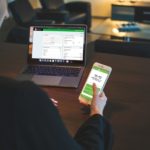I am often asked for tips and tricks for finding a topic in my doctorate or for a thesis. I have already written some guidelines for finding a topic. However, some of my readers are also interested in my personal story. I would therefore like to explain them in the following. By the way, my topic is: Effects of digitization on SMEs with knowledge-intensive services – results of empirical studies.
Reading tip: Find a topic for a thesis
In the first step, I thought about: What do I actually want to do? Then I read literature and, in the third step, interviewed practitioners. So, on the one hand, I wanted to make sure that there was enough literature and, on the other hand, that the topic would interest someone. Then I will say a few words about the implementation.
Step 0: Preparation – “What do I actually want” and organization.
Before I could start my doctorate, I had to find a doctoral supervisor and also an employer and a topic. I would like to tell my story about it. I was very lucky that I had already been with an employer for 1 year that wanted to support my doctorate. Furthermore, I already knew my doctoral supervisor very well and theoretically had no search process. However, if you want tips on this then take a look at the end of the article.
In the first step, my doctoral supervisor told me that I should decide on a direction. I should take a glass of wine and think about it in peace. After I had agility as my main topic at work and at university for a long time, that was of course clear. Unfortunately, agility as a topic was already well researched and I found that agility in the context of digitization is almost re-explored. So I had the rough vision that I would like to research the effects of digitization and the first work topic in my head: Influence of digitization on the agility of companies.
My tip: To get started, just take a broad topic that you enjoy.
Step 1: Theory – Literature Analysis on Digitization
Now I’ve built a search string and summarized all of the literature on digitization in clear clusters. To do this, I looked at the titles, abstracts and keywords of over 4000 publications in academic databases and evaluated them. In doing so, I came across the 10 topics Industry 4.0, automation, work, leadership, agility, cloud computing, big data, innovation, business models and globalization. I then briefly described these subject areas and prepared them on 10 PowerPoint slides.
My tip: Take your time to look around in the literature and combine them into clusters. This gives you an overview of where there is sufficient literature for research.
You can find the study on this at Springer or in the blog at: Topics of digitization.
Lindner, D., & Christian Leyh. (2019). Digitization of SMEs – questions, recommendations for action and implications for IT organization and IT service management. HMD – Praxis der Wirtschaftsinformatik , 4th , 21.
Step 2: Practice – Roundtable on digitization
Now I looked for practice partners in my environment and asked them to prioritize and substantiate these topics with me in a round table. I simply asked company managers I know and wrote to interesting profiles on Xing. Some other participants were also recommended to me. In the end, 12 managers were gathered in a round table.
First I made a list of participants and asked myself: who actually came? In which drawer can this group be put? I quickly realized that 10 of the 12 participants were from IT service providers who classify themselves as SMEs. That’s why I was able to quickly expand my topic: Effects of digitization on SMEs with knowledge-intensive services. At that time, in order to retain flexibility, I did not use IT service providers but rather knowledge-intensive services. Otherwise I would have had to exclude some practice partners from the round table.
In the round table I briefly presented all 10 subject areas and asked which of them were exciting. My specific question was: What do I need to research so that you will want to work with me for the next 5 years? The result was that the participants wanted individual studies in the areas of work (separated into workplace IT and work models), leadership and agility. As a first study, agility should be researched. Then I wrote down the wishes of the participants in more detail and planned the next round table.
My tip: ask in practice which topics from the literature are of interest. This ensures relevance and also secures the necessary practice partners.
Step 3: Implementation – on the shoulders of giants
Now I should find my academic niche, mentors and community. My doctoral supervisor recommended that I look for 3-5 papers that do almost exactly what I want to do. Papers that inspire me and are academic. So my search began in the already identified 4000 papers and I stopped at 4 posts:
- Bley and Leyh (2016): Digitization: Opportunity or Risk for German SMEs? – A study of selected companies
- Werth and Greff (2016): Consulting 4.0 – the digitization of management consulting
- Urbach and Ahlemann (2016): The Knowledge Workplace of the Future: Trends, Challenges and Implications for Strategic IT Management
- Ludwig et al. (2016): Working in Mittelstand 4.0 – SMEs in the field of tension of digital change
You stand on the shoulders of giants. The philosophy of science says: “A dwarf standing on the shoulders of a giant can see further than the giant himself”. Source TUHH . So in science, scientists build on other findings.
All four articles were from the HMD – Praxis der Wirtschaftsinformatik. I read this several times and based it on four abstracts for follow-up studies, which I sent to the authors. All authors were very nice and a total of 4 studies followed, each of which I carried out with one of the authors. All the writers were very nice and taught me a lot. Another advantage was that I had direct access to experienced mentors and also knew in which journal I would like to submit. I would like to thank all of the co-authors once again for this. So the structure of my doctorate was as follows:
- Preliminary study for finding a topic (literature analysis and round table)
- Study 1 to 4 (work models, workplace IT, leadership and agility)
- Final summary of the four studies (generalization)
My tip: Once you have a good idea of what you want to do, find similar studies that you like and work with the authors.
Step 4: Write and hand in the work
Now you have to summarize all the results and studies of the last few years and pack them into a 150-400 page document. Calculate about 12 months, as you have to coordinate this work comprehensively with the doctoral supervisor and have to change it many times. It is important that the work looks like it is all of a piece. In this phase the motto is: write and persevere! Also remember: Now only your doctoral supervisor counts! Nobody else can give you feedback because in the end they will evaluate the work.
My tip: cancel Netflix 😉
Tip: Download my step-by-step guide to finding a topic.
Excursus: Finding a doctoral supervisor and an employer
In conclusion, in this paragraph I would like to give you tips on how to organize your doctorate. First I would like to say something about the supervisor and then about the employer and answer the question: should I do a doctorate.
Find a PhD supervisor
If you want to find a doctoral supervisor, you should definitely write an exposé (1-3 pages). Content is the broad topic as well as your motivation. This page answers all known W-questions:
- Who is writing this doctorate?
- What do I want to edit?
- When do I want to take which steps?
- Where do I want to write this doctorate (research area)?
- Why do I want this PhD?
- How do I want to proceed?
- Why do I want to research the topic?
Now you can send this expose to various professors with a classic application (including a résumé). You can decide whether you want to do your doctorate internally or externally. I myself was external to the chair and can only give tips. You can find a good article on internal doctoral studies in PhD forum . However, my tips for applying for an external doctorate are as follows:
- Look specifically for chairs that external doctoral students already have
- The topic should please the professor and also fit the chair
- You will meet the professor every 2-3 months. So it doesn’t matter if he lives 100KM away or not. Apply anywhere in Germany.
Find an employer with an external doctorate
It’s a bit more difficult with the employer. Corporations often have doctoral programs that are actually quite OK. At least that’s how I find out from colleagues. So you can keep an eye out for it too.
Flexible working models can also often be found in medium-sized companies. Simply speak to your board of directors. Usually a good compromise can be found with a longer period of affiliation. But keep in mind that you will then have another party on board.
Alternatively, I recommend that you first reduce your work to 32 hours and simply start your doctorate. Still living well with a good salary in IT. With 2-3 days of effort per week (day off + Sunday) you will usually make good progress. Also expect a few short nights before paper deadlines etc.
Should I do a doctorate?
Now you are probably asking yourself: should I do a doctorate alongside my job? The question is actually quite easy to answer. Ask yourself the following questions:
- Am I ready to give up a career for 5 years?
- Am I willing to forego money for 5 years?
- Would I like to work on a topic for 5 years?
- Do I really want to learn scientific work?
- Do I have the iron will to do my doctorate?
- Do I really want the doctorate not just because of the title?
- Am I ready to give up my hobbies and sideline jobs?
A doctoral thesis often causes a career standstill due to the lower performance in the job. It is almost impossible to give 300% on the job during the day and then still work in the doctorate in the evening. So you have to switch back a bit. You also need help from freelancers (proofreading or transcripts) to have time off your job. You will also have to pay for the cost of the conference yourself. The doctorate will also take a lot of time. For example, I haven’t watched any series in the three years and haven’t had any direct hobbies except a little fitness. You have to be completely fixated on this work.
So are you ready to forego 5 years of career and money for this additional training so that you can enjoy lifelong benefits afterwards? If you answer yes, then start your application today!
[student]Image source: Pixabay.com
[fotolia]


